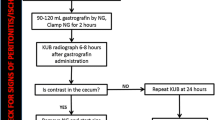Abstract
The diagnosis of small bowel obstruction (SBO) by abdominal computed tomography previously often included both intravenous and oral contrast agents. Recent guidelines suggest that oral contrast agents (gastrografin, barium) are unnecessary, as they significantly delay diagnosis, falsely enhance adjacent bowel wall, and do not provide benefit over air and secreted fluids already in the bowel lumen. The administration of intravenous contrast in suspected SBO is beneficial and allows the provider to assess for bowel wall ischemia.
Access provided by Autonomous University of Puebla. Download chapter PDF
Similar content being viewed by others
Keywords
FormalPara Pearls and Pitfalls-
Recent guidelines suggest against using oral contrast in patients requiring computed tomography (CT) for suspected small bowel obstruction (SBO).
-
Intravenous contrast does not increase the sensitivity of CT but does allow for assessment of bowel ischemia.
-
Nearly 70% of emergency medicine providers continue to administer oral contrast when obtaining CT for suspected SBO.
I am Getting a CT for Small Bowel Obstruction, Do I Need Oral Contrast?
Prior studies and clinical practice guidelines have suggested the use of intravenous (IV) contrast, oral contrast (e.g., gastrografin, barium), or both for the diagnosis of small bowel obstruction (SBO) by abdominal computed tomography (CT).
Oral contrast typically requires an observation period following its administration to allow opacification of the small bowel and passage of contrast into the colon to exclude complete or high-grade obstruction [1]. In addition to this required delay, contrast ingestion itself may take a significant amount of time, especially in patients with SBO. A recent study showed a median time of greater than 100 min for oral contrast ingestion, even with prophylactic antiemetics. Oral contrast resulted in delayed diagnosis and increased emergency department length of stay [2]. A frequent argument against oral contrast is that the diagnosis of SBO with CT can be made by the presence of secreted fluids and ingested air, which are already present in the bowel lumen and provide sufficient contrast to detect bowel dilation [3].
The American College of Radiology (ACR) Appropriateness Criteria guidelines suggest against administering oral contrast in patients suspected of small bowel obstruction because it “will not reach the site of obstruction, wastes time, adds expense, can induce further patient discomfort, will not add to diagnostic accuracy, and can lead to complications, particularly vomiting and aspiration” [4].
Despite the ACR’s recommendation, a recent study showed that 69% of emergency medicine providers continue to administer oral contrast when obtaining CT for SBO [5].
IV Contrast?
Recent literature has shown that the average sensitivity of an entirely non-contrast CT for SBO is 88.1% [6]. Adding IV contrast does not significantly alter CT’s sensitivity for SBO, but it does improve assessment for bowel ischemia, an important sequela of SBO that generally requires urgent operative intervention.
After IV contrast administration, small bowel with an intact blood supply appears with a thin and complete bright wall on CT. The absence of enhancement is highly specific for bowel wall ischemia. Sometimes administration of oral contrast can make differentiating between healthy and ischemic bowel difficult because it hinders the ability to determine whether there is appropriate bowel wall enhancement after IV contrast [7]. For this reason, many argue that oral contrast should be avoided if suspecting an SBO [7]. The IV contrast-enhanced CT shown in Fig. 49.1 depicts an SBO.
In conclusion, evidence-based literature suggests that CT for suspected SBO should be performed with IV contrast whenever possible. Oral contrast does not provide benefit and may cause harm.
Suggested Resource
-
Broder J. CT of small bowel obstruction. Emergency physicians monthly. October 2015: http://epmonthly.com/article/ct-of-small-bowel-obstruction/
References
Paulson EK, Thompson WM. Review of small-bowel obstruction: the diagnosis and when to worry. Radiology. 2015;275(2):332–42.
Garra G, Singer AJ, Bamber D, Chohan J, Troxell R, Thode HC Jr. Pretreatment of patients requiring oral contrast abdominal computed tomography with antiemetics: a randomized controlled trial of efficacy. Ann Emerg Med. 2009;53:528–33.
Furukawa A, Yamasaki M, Takahashi M, Nitta N, Tanaka T, Yokoyama K, Murata K, Sakamoto T. CT diagnosis of small bowel obstruction: scanning technique, interpretation and role in the diagnosis. Semin Ultrasound CT MR. 2003;24(5):336–52.
National Guideline Clearinghouse (NGC). Guideline summary: ACR Appropriateness Criteria® suspected small-bowel obstruction. In: National Guideline Clearinghouse (NGC). Rockville (MD): Agency for Healthcare Research and Quality (AHRQ); 2013. [cited 2017 Jul 17]. Available: https://www.guideline.gov
Broder JS, Hamedani AG, Liu SW, Emerman CL. Emergency department contrast practices for abdominal/pelvic computed tomography-a national survey and comparison with the American College of Radiology Appropriateness Criteria. J Emerg Med. 2013;44:423–33.
Atri M, McGregor C, McInnes M, Power N, Rahnavardi K, Law C, Kiss A. Multidetector helical CT in the evaluation of acute small bowel obstruction: comparison of non-enhanced (no oral, rectal or IV contrast) and IV enhanced CT. Eur J Radiol. 2009;71:135–40.
Sheedy SP, Earnest F, Fletcher JG, Fidler JL, Hoskin TL. CT of small-bowel ischemia associated with obstruction in emergency department patients: diagnostic performance evaluation. Radiology. 2006;241:729–36.
Author information
Authors and Affiliations
Corresponding author
Editor information
Editors and Affiliations
Rights and permissions
Copyright information
© 2019 Springer Nature Switzerland AG
About this chapter
Cite this chapter
Gettel, C., Cummings, C. (2019). So I am Getting a CT for Small Bowel Obstruction, Do I Need Oral Contrast? IV Contrast?. In: Graham, A., Carlberg, D.J. (eds) Gastrointestinal Emergencies. Springer, Cham. https://doi.org/10.1007/978-3-319-98343-1_49
Download citation
DOI: https://doi.org/10.1007/978-3-319-98343-1_49
Published:
Publisher Name: Springer, Cham
Print ISBN: 978-3-319-98342-4
Online ISBN: 978-3-319-98343-1
eBook Packages: MedicineMedicine (R0)





